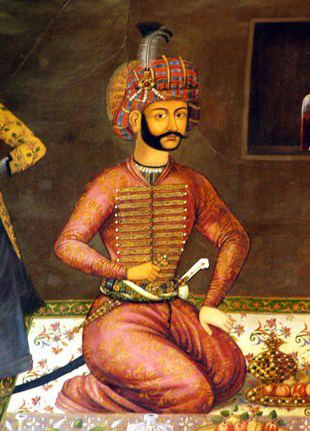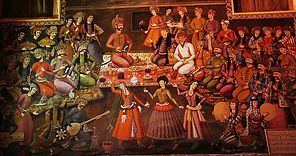Coronation 15 May 1642 House Safavid dynasty Grandchildren Sultan Husayn Burial Qom Children Suleiman I of Persia | Successor Suleiman I Role King Predecessor Safi I Name Abbas of | |
 | ||
Reign 15 May 1642 – 26 October 1666 Born 31 December 1632
Qazvin ( 1632-12-31 ) Died September 25, 1666, Khusruabad Parents Anna Khanum, Safi of Persia Grandparents Dilaram Khanum, Mohammad Baqer Mirza Similar People Sultan Husayn, Nader Shah, Aurangzeb, Dara Shikoh, Murad Bakhsh | ||
Shah Abbas II (Persian: شاه عباس دوم, Shāh Abbās) (30 August 1632 – 26 October 1666), was the seventh Safavid king (shah) of Iran, ruling from 1642 to 1666. Born Soltan Mohammad Mirza, he was the eldest son of Safi I with his Circassian wife, Anna Khanum.
Contents
- Early life
- Accession and early reign
- War with the Mughal Empire
- Events in the Caucasus
- Death and succession
- Characteristics and appearance
- Issue
- References

Abbas II was undoubtedly the most capable and energetic Safavid shah after his great-grandfather Shah Abbas I the Great (r. 1588–1629), whom he in many aspects bore resemblance to. Albeit Abbas II ascended the throne at the age of merely 9 years old, he showed considerable toughness and resolve—in 1645, no longer than three years after his succession, the grand vizier Saru Taqi was murdered by a faction of the Qizilbash led by the qurchi-bashi Jani Beg Khan Shamlu, one of the most influential administrators of the country; in the ensuing days, Abbas II had all the perpetrators put to death.
Similar to Abbas I, Abbas II possessed a strong dedication for fairness, and objections of misconduct and injustice by civil servants were promptly taken care of, whilst the responsible individuals were strictly penalized.
Early life
Abbas II was born as Soltan Mohammad Mirza in Qazvin on Monday, 30 August 1632. He was the son of Shah Safi I and a Circassian, Anna Khanum. He was the oldest of five brothers. Not much is known about Mohammad Mirza's youth, except that he spent his youth in the Safavid harem, and was tutored by his mentor Rajab Ali Tabrizi. He also learned how to maintain order over a state and other royal matters by the steward (nāẓer) of the royal household, Mohammad-Ali Beg, and the head of the royal bodyguard (qurchi-bashi), Jani Beg Khan Shamlu.
Accession and early reign
On 15 May 1642, at Kashan, Mohammad Mirza was crowned as shah of Iran and chose "Abbas II" as his dynastic name. Since he was less than ten years old when he became shah, the job of governing Persia was placed in the hands of his mother, Anna Khanum, and the grand vizier, Saru Taqi, while Abbas concentrated on his education at Qazvin. Anna Khanum and Saru Taqi worked closely together, and under them Iran was in secure hands. The French traveller Jean Chardin noted their close working relationship, saying:
The power of mothers of Persian kings looms large when they [shahs] are at a young age. Abbas II's mother had much influence, which was absolute. She [the queen mother] was in close contact with the prime minister and they would help each other. Saru Taqi was the agent and confidant of the queen mother; he would gather immense fortunes for her. She governed Persia at her will through her minister.
After one year had passed, Abbas II moved to the Safavid capital of Isfahan. During the same year, the powerful general Rustam Khan, refused to obey Safavid orders, and marched towards Isfahan to depose Abbas II. However, Saru Taqi managed to have him killed at Mashhad.
In 1644, some Bakhtiari tribes rebelled against Abbas II. The rebellion, however, was quickly suppressed by Saru Taqi. Saru Taqi led a drive against corruption and, as a result, made many enemies. On 11 October 1645 he was assassinated by a group of army officers. Abbas II then appointed Khalifa Sultan as his grand vizier on October 14. Khalifa Sultan had at first declined the offer, but quickly alter accepted. His established bureaucratic proficiency and past knowledge were definitely the deciding factors in this reappointment, albeit it may be possible that Abbas II recalled him into service in part with the goal of compressing the discontent about the scarcity of the positions given to men of religion under his predecessor.
War with the Mughal Empire
Unlike his father, Abbas II took an active interest in government and military matters once he began to rule for himself (probably around age 15). In the summer of 1648, Abbas II, who sought to recapture Kandahar from the Mughal Empire, marched from Isfahan with an army of 40,000 men and after capturing Bost, he laid siege to Kandahar and captured it after a brief siege on 22 February 1649. Abbas II then appointed the Georgian ghulam ("military slave") Mihrab Khan as the governor of the city. The Mughals attempted to retake the city in 1651 but the arrival of winter forced them to suspend the siege.
The Mughal ruler Shah Jahan then sent his son Aurangzeb with an army of 50,000 soldiers to recapture Kandahar. Although Aurangzeb defeated Abbas II outside the city, he was unable to take it. His artillery train proved not up to the task. Aurangzeb attempted to take the fortress city again in 1652. In the meantime, Abdul Aziz, the Uzbek ruler of Bukhara, had entered into an alliance with Abbas II, and in May 1652, he dispatched 10,000 troops to Kabul to harass the Mughal supply lines. Though not strong enough to lift the siege, the Uzbek threatened a Mughal convoy of 2,000 troops who were escorting one and a half million silver coins to the besieger's army at Kandahar. After two months of fighting Safavid resistance, along with the growing activities of the Uzbeks, Aurangzeb was forced to abandon the campaign. In 1653, the Mughals tried to take it once again, but failed doing so. The city would subsequently remain in Safavid hands until its fall in 1736.
Events in the Caucasus
In 1651, Safavid troops clashed with those of the Tsardom of Russia in the North Caucasus, known as the Russo-Persian War of 1651-163. The main issue involved the expansion of a Russian garrison on the Koy Su River, as well as the construction of several new fortresses, in particular the one built on the Iranian side of the Terek River. The Safavid government then sent troops, and destroyed the fortress while expelling its Russian garrison. Soon however, another conflict on the war's eastern front had started. At the same time, the Russian government sent an embassy, led by courtier Prince Ivan Lobanov-Rostovsky and steward Ivan Komynin, to Isfahan to seek a peaceful settlement of the conflict. Abbas II agreed with the settlement offer as he wanted to settle the issue in the far eastern territories first. The war ended with no further territorial gains, but the Safavids manage to increase their influence in the North Caucasus.
In 1654, Abbas II appointed the Georgian prince Vakhtang V as the ruler of Georgia. In 1656, the people of Isfahan rebelled against Parsadan Gorgijanidze, who was the prefect of the city. Abbas II quickly had Parsadan removed from the office and appointed him as the Master of ceremonies of the Safavid court.
In 1659, the Kingdom of Kakheti rose up against the Safavid Iranian rule, known as the Bakhtrioni Uprising, due to a change of policy that included the settling of Qizilbash Turkoman tribes in the region. This action was implemented by Abbas II's government for a number of reasons, amongst them being the need to repopulate the province, as Shah Abbas I' mass deportations of between 130,000 - 200,000 Georgian subjects to Persia's heartlands and massacre of another thousand in 1616 left this part of the province substantially underpopulated. Another reason was to keep an eye on the restive nobles. Yet another reason was due to the fact that the Safavid possessions in Georgia were geographically close to the Daghestan province. From Daghestan, Lezgins marauders frequently organized raids into parts of the northwestern Safavid domains, including Safavid Georgia. Lastly, it was also decided as a measure against Russia, which had increased its pressure on Daghestan, a neighboring province of the Georgia province. Anyhow, Iranian authority was restored in Kakheti, but the Qizilbash Turkics were prevented from settling in Kakheti.
Death and succession
Abbas II's reign was relatively peaceful and was significant for being free of any Ottoman attack. Abbas II, like his great-grandfather Abbas I, was famous for the construction of many buildings, such as the famous Chehel Sotoun in Isfahan. He died in Khosrowabad near Damghan on the night of 25–26 October 1666, and was buried alongside his father in Qom. He was succeeded by his son Suleiman I. He also had sons named Hamza Mirza, Ismail Mirza and Mirza Ali Naqi, and had two daughters.
Characteristics and appearance
European travelers and locals, who were charmed by the hospitality and the favorable marketing circumstances of the Iranian court, usually described Abbas II's character and nature in a positive light. The ambassador of the Dutch East India Company, Joan Cuneaus, who made acquaintance with Abbas II in March 1652, where he and the visitors were permitted to drink from the shahs wine chalice, portrayed him as being of medium height, somewhat skinny, agile, and beardless.
Issue
Abbas II married several times;
